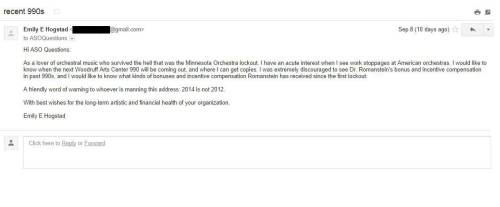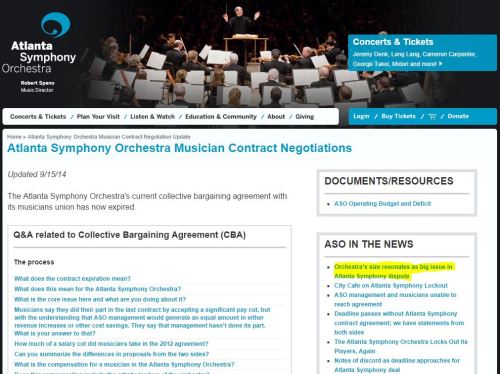As the house lights dimmed in Orchestra Hall on Sunday afternoon, I relaxed into the thought: when I write my next entry, I can focus on the music. I won’t need to write about barn-burning musician speeches, a defiant audience Euro-clapping and waving Finnish flags, or recurring flashbacks about being on the wrong side of the shrubbery. Instead, I’ll be able to write about how our Minnesota Orchestra performed Mahler and Barber.
That is as it should be. That feels good.
And so it is that Minneapolis is gradually acclimating to life post-lockout. We’re like a man who has been in a terrible car crash, gingerly testing out each arm and leg, finding that each limb is still (somehow) in working order. We’re a little bruised and battered. But still whole. And blessed with a whole new appreciation for life, and a whole new sense of purpose, direction, and focus.
The Minnesota Orchestra’s 2014-2015 season opening concert was marketed as a celebration of resurrection, but it was also a paean to ambition. A mere Mahler 2 wasn’t enough for Osmo and his musicians, so they also programmed the Barber cello concerto, one of the most difficult pieces ever written for that instrument. After our long musical drought, this two-and-a-half-hour concert felt like Thanksgiving dinner after a long fast. Trust me, our ears gorged on this music.
Superstar Alisa Weilerstein was the soloist. After he was commissioned to write a concerto for cellist Raya Garbousova, Samuel Barber told her to play her repertoire for him. He was obviously impressed with what he heard. Garbousova and Barber were in close contact during the concerto’s composition, exchanging ideas and inspiration. In a canon that skews so heavily male (Fun Factoid!: the works of Beethoven are performed more often than the works of all women composers combined), I cherish these stories of strong women who shaped our repertoire.
Alisa Weilerstein is the archetype of a strong woman. She is a force of nature – a pagan high priestess – a warrior cello Athena. She tore into the ferocious solo part with equal parts fire and grace, the white hot intensity of her concentration blinding. One moment she was crouching over her cello, listening intently with her ear tilted down. The next she was rolling her head back to watch Erin’s bow, Osmo’s hand – then abruptly lurching forward again to attack another triple stop, another sky-high broken arpeggio. There were a few brief scattered moments where I felt orchestra and soloist weren’t completely synched – Weilerstein’s approach to rhythm might be a bit…impulsive? – but she can carry it off, and if anything, her freedom just added drama to the performance. The third movement in particular was wildly virtuosic, completely impossible, breathtakingly death-defying, a fast unicycle ride on a high wire. It the classiest, brainiest, most exhilarating curtain-raiser imaginable. Next time she comes to town, you simply must go.
Then after intermission came Mahler 2. (Like I said, we were gorging.)
There is a famous old story of Mahler and Sibelius discussing the role of the symphony. Sibelius appreciated the genre’s “profound logic and inner connection.” Mahler disagreed: he said that “A symphony must be like the world. It must embrace everything.”
As we all know, Osmo’s calling card is Sibelius. (Rightly so.) And yet – somehow – his interpretive gifts serve both Sibelius and Mahler brilliantly. Osmo excels at immediately grasping the geography of a piece, no matter how complicated. He’s a perfectionist, but he somehow never gets caught in the weeds. He coaxes the most extraordinary superhuman dynamics from his players. He is honest; he is plainspoken; he abhors artifice. All of those strengths are what make his Sibelius so special.
And here’s the interesting thing: they’re also the strengths that make his Mahler so special, too. And by special, I mean “really really special.” And by really really special, I mean “holy crap, I think we have a Mahler conductor and orchestra on our hands.”
From the very first tremolo, it was clear that Osmo and his band were going to twist the Intensity Knob up to “Batshit Crazy.” And so accordingly, on the very first page, while attacking the growling cello part, principal Tony Ross had a Tony Ross String Incident (TM). Wasting no time whatsoever, he whipped his cello around like it was his dance partner, suddenly had a new C-string in his hand, silently re-tuned, then jumped back in with both feet, no fear, no timidity whatsoever. I mention it because the incident encapsulated the attitude of the whole performance: Let’s just go for it.
Tony’s passion set the bar for intensity. And it was a bar every exhausted musician met again, and again, and again. (Remember, this was their third performance in as many days.) The first movement chromatic death motif was haunting – it turned my stomach – and whenever it found its way into the bass registers, it shook our very seats. The fierce col legno clattering of bow wood on strings brought to mind dancing skeletons. Now and then ethereal moments of hope or even heroism peaked through the texture – rising chords in the brass, the pluck of harp strings, wistful lines in the winds – but they were invariably submerged or absorbed by shifting keys or orchestration. Osmo looked like a traffic cop up there, directing the various piano, mezzoforte, forte lines crossing and intersecting, rising, falling, all the while sculpting, molding, the results, revealing details previously buried away in the labyrinthine tangle of a score.
After the movement seemed to have exhausted itself, a wary peace seemed to descend…
And then, with a jab of Osmo’s hand, an anguished trumpet wail smeared a half-tone down. The following mechanical staccato triplets in the strings made it feel as if the very ground had fallen out from beneath us – and the nearly silent pizzicatos after that thudded like handfuls of dirt thrown onto a coffin.
Devastating.
The simple second movement is a Ländler, an elegant country dance. I’d always thought of it as a rather slow and gentle piece of music, ostensibly meant to contrast with all the death and destruction that has preceded it. Wikipedia says it’s an evocation of happy times in the life of the deceased. But this ländler felt like something different. Yes, it was slow and gentle, but it also had a sinister edge to it, intensified by dynamics one had to strain to hear, as well as rocking phrasing that hit on the rhythms just a tad too hard for a traditional ländler. Melody lines that sound merely lovely in other interpretations came across here as (subtly) sassy double entendres, as bitter muttered inside jokes. And this slightly surly attitude just served to intensify the more outright sarcasm of the third movement. Rolling themes whirled from section to section, showcasing each, constantly changing form, reinventing themselves, unfurling from corner to corner of the stage. It really is an experience to hear a Mahler symphony done live by a major orchestra; Sunday afternoon I realized yet again how recordings are the equivalent of pencil sketches of oil paintings. Anyone who thinks they can truly absorb music solely through recordings is delusional.
Then. After an hour of stunning instrumental color, came the contrast of a single female voice, singing a simple melody. The soloists were sitting behind the orchestra, and at least from my seat, the ascent of this anonymous human voice came a surprise. I didn’t see her stand or open her mouth; there was just, suddenly…sound. Effortless sound. Hugely moving sound. Human sound. Once that voice arrived, all the performance’s snark and sarcasm collapsed, and the energy came instead from a clear-eyed earnestness.
And so as the afternoon went on, the plot of the symphony slowly began to shed its outer layers of despair, cynicism, and world-weariness. We saw and heard fresh glimpses – suggestions, promises of a mighty world to come – obscured now by aural clouds, by sinister orchestration – then re-announced by bold choruses of horns and strings. The sounds came in waves, pounding then receding, almost like the ocean in La Mer.
The moments in which Osmo cued the offstage horns were particularly breathless: his eloquent hand suspended, just barely trembling. That simple gesture from the podium triggered muted faraway calls in another room, another world.
It took me a long while to figure out how to interpret that wide-ranging sprawl of a last movement. The closest I got to a narrative was imagining it as some kind of secular religious service in which the orchestra, chorus, and audience communally worships Art, or maybe the Art in God. I’m Episcopalian, and our Book of Common Prayer contains services for baptism, marriage, last rites, funerals…ceremonies for birth, love, sickness, and death. Paging through our slim little book, you go from the height of human joy, to the depths of human grief, then back again, all in the course of a few minutes. The symphony’s closing half hour reminded me of that idea – in fact, only made sense to me within the context of that idea: symphony as a form of worship. And so listening, there was more than one moment when I wanted to kneel and bow my head, cross myself, murmur ancient prayers, giving thanks at this sacred altar for blessings received. That impulse of spiritual reverence only strengthened when the hushed tones of the Minnesota Chorale entered. Whenever their voices fell silent, I suddenly realized I hadn’t been breathing, that I had no idea how long they’d been singing. Had it been two minutes? Ten? Sixty? They were transporting.
At the epic ending, voices rose, brass soared, bells clanged. They sounded like a church’s pealing after a war. As the final chords sounded, more than one face sparkled wet with tears of awe and gratitude at the magnificence arrayed before us. Here in a blaze of sonic glory was a fiery world created anew.
Rise again, yes, you will rise again,
My heart, in the twinkling of an eye!
What you have conquered
Will bear you to God!
“It’s so obvious,” a musician told me afterward. “But it doesn’t matter.”
***









